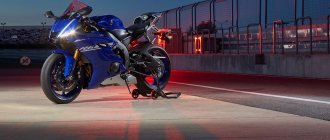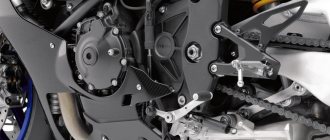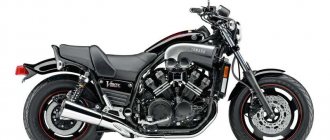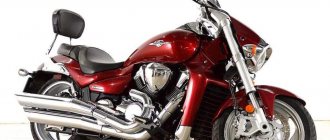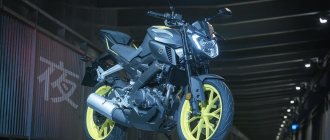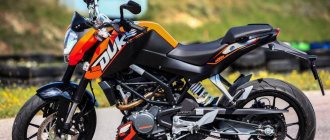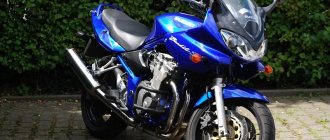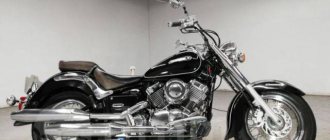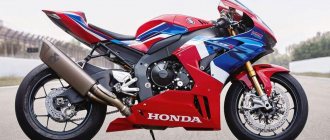| Yamaha R6 (1999-2002) | Yamaha R6 (2003-2004) | Yamaha R6 (2005) | Yamaha R6 (2006-2007) |
| Yamaha R6 (2008-2009) | Yamaha R6 (2010-2016) | Yamaha R6 (2017-2021) |
| Yamaha R6 Race (2022) <track only> | Yamaha R6 GYTR (2022) <track only> |
Yamaha R6 (YZF-R6) sports motorcycle model
appeared on the market in 1998 (1999 model year) as a successor to the Yamaha YZF600R Thundercat (which was also produced at the same time, but positioned itself as a sports tourer) and as a junior version of the Yamaha R1 (YZF-R1).
The basis was a new engine with a volume of about 600 cm³, liquid cooling, producing up to 120 hp. Compared to the Thundercat, the engine has become shorter stroke, has forged pistons with a low coefficient of friction, a new crankshaft, connecting rods, ignition system, two-pin spark plugs and Mikuni carburetors with a throttle position sensor.
In 2001, the Yamaha R6 engine received minor changes that affected the connecting rods, pistons, exhaust system, ignition system and battery (a slightly lighter one with a smaller capacity began to be installed).
In 2003, the model underwent its first major restyling. The appearance of the plastic and the headlight changes, the wheels become 5-beam. The updated model receives an injector instead of a carburetor, which led to a noticeable increase in traction in the low and medium speed zone, although the maximum power remained at the same level - 120 hp. New generation of Deltabox frame. Curb weight is reduced by 6 kg.
In 2005, the Yamaha YZF-R6 model is changing again. The motorcycle is equipped with a 41 mm inverted fork and radial calipers, the diameter of the front brake discs increases: 298 → 310 mm. As for the engine, the model receives modified intake and exhaust systems (the diameter of the exhaust manifold has been increased to 40 mm). The front tire size changes: 120/60ZR17 (55W) → 120/70ZR17 M/C (58W).
A year later, in 2006, the Yamaha YZF-R6 undergoes another major restyling. The appearance of the plastic, headlights and exhaust system changes. The model receives a new engine with inertial supercharging, producing up to 127 hp. (122 hp - naturally aspirated). The fuel tank capacity increases: 17.0 → 17.5 l. The model also receives an electronic throttle (YCC-T - Yamaha Chip Controlled Throttle) and an injection system with dual injectors (Mikuni 40EIS → Mikuni 41EIDW). The gearbox ratios change, the clutch gets a slip function. The motorcycle gets a new ignition system (DC CDI → TCI). The engine receives titanium valves, lightweight forged pistons, a titanium exhaust system with EXUP valves, and a lightweight flywheel.
In 2008, the model changes again, although visually it is very similar to the previous generation. The fuel tank capacity decreases slightly: 17.5 → 17.3 l. The engine increases the compression ratio: 12.8 → 13.1. Maximum power increases to 129 hp. (with inertial supercharging). The model receives a system with automatically variable intake manifold length - YCC-I (Yamaha Chip Controlled Intake).
2010 was marked by another small restyling of the Yamaha YZF-R6 model. The model receives an updated appearance, a new engine management program and a new exhaust. Curb weight is 189 kg. Maximum engine power is 123.8 hp.
For 2021, the motorcycle changes again, taking on the visual cues of the new Yamaha R1. The model is equipped with a 43 mm inverted fork, a new rear shock absorber, a new braking system (increased to 320 mm brake discs, ABS), an aluminum fuel tank, a magnesium subframe and a new aerodynamic system (reduces air resistance by 8%). New electronic systems have appeared: TCS (Traction Control System) and D-Mode (Selectable Drive Mode). Maximum power is 118.4 hp. Curb weight - 190 kg.
2021 marks the final year of production for the Yamaha R6. On the European market, the R6 model was still represented by the presence of racing modifications (for track driving only) - R6 Race and R6 GYTR. As a replacement for the R6, Yamaha has released a budget sportsbike - the Yamaha R7 2022.
Yamaha R6: electronic equipment
- YCC-T (Yamaha Chip Controlled Throttle) - since 2006
- YCC-I (Yamaha Chip Controlled Intake) - since 2008
- ABS - from 2021
- TCS (Traction Control System) - from 2021
- D-Mode (Selectable Drive Mode) - from 2021
- QSS (Quick Shifter System) up - from 2021
The main competitors of the Yamaha R6 in the class:
- Honda CBR600RR
- Suzuki GSX-R600
- Kawasaki ZX-6R
Brief history of the model
- 1999 - start of production and sales. First generation
.
Model
: Yamaha YZF-R6 (Europe, North America, Australia).
Factory designation
: 5GV1, 5GV2, 5GV3, 5EB1, 5EB2, 5EB3.
- 2000 - no significant changes.
Model
: Yamaha YZF-R6 (Europe, North America, Australia).
Factory designation
: 5GV4, 5GV5, 5GV6, 5EB5, 5EB6, 5EB7, 5EB8.
- 2001 - minor changes to the model (described in detail at the beginning of the review).
Model
: Yamaha YZF-R6 (Europe, North America, Australia).
Factory designation
: 5MT1, 5MT2, 5MT3, 5MT4, 5MT6, 5MT7, 5MT8, 5MT9, 5MTA.
- 2002 - no significant changes.
Model
: Yamaha YZF-R6 (Europe, North America, Australia).
Factory designation
: 5MTB, 5MTC, 5MTD, 5MTE, 5MTF, 5MTG, 5MTH.
- 2003 - restyling of the model. Second generation
.
Model
: Yamaha YZF-R6 (Europe, North America, South Africa, Australia).
Factory designation
: 5SL1, 5SL2, 5SL3, 5SL4, 5SL5, 5SL7, 5SL8, 5SL9.
- 2004 - no significant changes.
Model
: Yamaha YZF-R6 (Europe, North America, South Africa, Australia).
Factory designation
: 55SLB, 5SLC, 5SLD, 5SLE, 5SLF, 5SLH, 5SLJ.
- 2005 - restyling of the model. Third generation
.
Model
: Yamaha YZF-R6 (Europe, North America, Japan, Australia).
Factory designation
: 5SLS, 5SLR, 5SLW, 5SLV, 5SLX, 5SLN, 5SLM, 5SLP, 5SLT, 5SLU.
- 2006 - restyling of the model. Fourth generation
.
Model
: Yamaha YZF-R6 (Europe, North America, Japan, Australia).
Factory designation
: 4P61, 4P62, 4P63, 2C01, 2C02, 2C03, 2C05, 2C06, 2C07, 2C08, 2C09, 2C0A.
- 2007 - no significant changes.
Model
: Yamaha YZF-R6 (Europe, North America, Japan, Australia).
Factory designation
: 4P64, 4P65, 4P66, 2C0B, 2C0C, 2C0D, 2C0F, 2C0G, 2C0H.
- 2008 - restyling of the model. Fifth generation.
Model
: Yamaha YZF-R6 (Europe, North America, Japan, Australia).
Factory designation
: 4P68, 4P69, 13S1, 13S2, 13S4, 13S5, 13S6, 13S8, 13S9, 13SA.
- 2009 - no significant changes.
Model
: Yamaha YZF-R6 (Europe, North America, Japan, Australia).
Factory designation
: 4P6A, 4P6B, 4P6C, 13SB, 13SC, 13SH, 13SJ, 13SK, 13SG, 13SM.
- 2010 - restyling of the model. Sixth generation.
Model
: Yamaha YZF-R6 (Europe, North America, Japan, Australia).
Factory designation
: 13SL, 13SR, 13SS, 13ST, 13SU.
- 2011 - no significant changes.
Model
: Yamaha YZF-R6 (Europe, North America, Japan, Australia).
Factory designation
: 13SV, 1JS5, 1JS1, 1JS6, 1JS2, 1JS7, 1JS3, 1JS8.
- 2012 - no significant changes.
Model
: Yamaha YZF-R6 (Europe, North America, Australia).
Factory designation
: 1JSL, 1JSG, 1JSP, 1JSR, 1JSD, 1JSA, 1JSE, 1JSB, 1JSS, 1JSF, 1JSC, 1JSL.
- 2013 - no significant changes.
Model
: Yamaha YZF-R6 (Europe, North America, Australia).
Factory designation
: 1JSU, 1JSV, 2CX1, 2CX2, 2CX3.
- 2014 - no significant changes.
Model
: Yamaha YZF-R6 (Europe, North America, Australia).
Factory designation
: 2CXB, 2CX4, 2CX9, 2CX7, 2CX8.
- 2015 - no significant changes.
Model
: Yamaha YZF-R6 (Europe, North America, Australia).
Factory designation
: 2CXE, 2CXL, 2CXJ, 2CXK.
- 2016 - no significant changes.
Model
: Yamaha YZF-R6 (Europe, North America, Japan, Australia).
Factory designation
: 1JSY, 2CXM, 2CXY, 2CXU, 2CXW, 2CXX, 2CXS, 2CXT.
- 2017 - restyling of the model. Seventh generation
.
Model
: Yamaha YZF-R6 (Europe, North America, Australia).
Factory designation
: BN64, BN63, BN61, BN62.
- 2018 - no significant changes.
Model
: Yamaha YZF-R6 (Europe, North America, Japan, Australia).
Factory designation
BN6A, BN6D
- 2019 - no significant changes.
Model
: Yamaha YZF-R6 (Europe, North America, Australia, Japan).
- 2020 - no significant changes.
Model
: Yamaha YZF-R6 (Europe, North America, Australia, Japan).
- 2021 is the last year of production.
Model
: Yamaha YZF-R6 (Europe, North America, Australia, Japan).
Comparison with analogues
In its category, it has competitors, which include motorcycle models such as the Honda CBR 600 RR, Kawasaki ZX6-R, Suzuki GSX 600 R.
They all compete with each other like racing motorbikes. Each model has its own advantages and disadvantages in racing competitions.
The latest ER-6 model has a quickshifter, although it only works when upshifting and of course not as quickly as on racing cars.
Despite the presence of similar motorcycles, Yamaha still wins due to its excellent handling . Among these models, the YZF R6 is the only one that has a magnesium subframe . All others are equipped with aluminum.
Reviews
Reviews about Yamaha R6 (YZF-R6):
Expand Collapse
A device for catapulting organic beings in space. the car is amazing and, having a normal head and skills, will give you those emotions that no other car can give. Not like the first spendthrift.
The best of 600! The brakes are excellent, steering is easy, it’s very comfortable in the city, but I’ll say right away that a very rigid motorcycle is more suitable for the track. I have almost nothing in terms of tuning, xenon low beam, sliders, tinted glass... there are a lot of things that can be modified for those who like to fool around, I bought it for the season so I didn’t invest.... I've driven about 5 thousand this season already, changed the oil and filters, tires from Dunlop to Pirelli, the difference is colossal... Dunlop is oak, I put it back 190. Who will say that it's technically not recommended, it's complete nonsense, I drive it, put it up to the feet and don't throw it out anywhere. I accelerated to a little over 270, maybe more was possible, but there was room, I only drive around the city and to the nearest Moscow region. As for reliability, I can’t say yet, but there are no problems, I’ve been driving normally for 7 years now, so I burn normally at times, and it doesn’t burn oil. In general, it may help someone when choosing. Use brake fluid 5.1, it heats up less, don’t skimp on tires and pads, oil every 2-3 thousand, in general, keep an eye on the condition, the motorcycle does not forgive mistakes and negligence, ALWAYS wear an outfit, preferably a full one, you only have one life, so take care of it.
The bike is excellent - for those who love a beautiful and aggressive sporty design and good dynamics, as well as reliability and ease of fit (for sports - this is very rare) the YZF R6 03-05 model, as well as the R6S produced before 2008, are essentially one and the same too, only the 2005 model has an inverted fork... this sportbike was simply born for the urban jungle, and it’s also quite comfortable to ride long distances... there were never any problems in those areas, I’m the 3rd owner, I rode for 2 seasons, I only changed consumables, total mileage about 40 thousand... these models easily go up to 100 thousand and more... it all depends on the operation, it doesn’t consume oil at all, consumption = a full tank of 95 (with beep) for 220 km (including reserve)... in the city you can easily make any liter... Because 200 liters don’t drive around the city and they are significantly inferior in maneuverability, the p6 steers like a bicycle = very comfortable, and up to 200 acceleration is like a liter, maximum speed is 260-270
YZF-R6 2005 is now perceived as a semi-tourist. The motorcycle is generally cool, but parts are rare. You'll get tired of looking for spare parts. In general, the motorcycle is reliable. The steering is not very nervous and sharp. Compared to the 2005 Siberian, it loses in taxiing. The ass wears out from intense braking. Cylinder heads are a weak point. They fell, fucked up, asshole.
YZF R6 2008-2010 — I liked literally everything. It steers sharply. Reacts quickly to the pilot's slightest wishes. The brakes simply bite into the asphalt (you need to be careful with them, the 2005-06 Honda is very forgiving when braking), but for experienced pilots this is a plus. Doesn't carry his ass during active braking. The engine is peppy. But twitchy. You need to be as careful as possible in the rain and when turning at large angles. I was pleased with the suspension - it works at 148%! =) Motik is a professional butterfly handler. Girls are thirsty. The plastic is beautiful on the outside, but in fact it's fragile as hell. What a JING Dynasty Vase! A non-repairable expensive toy that GOES! And how it goes. Let's just say... thanks to the duet of the engine and chassis, you have every chance to show the owners of liters your brake light. =) In the city... in a traffic jam... =)
Specifications
Initially, as expected, the motorcycle was developed for racing on specialized tracks. The developers paid maximum attention to the technical characteristics and engine.
Under the plastic body kits hides the canonical in-line four with a volume of 599 cc. cm.
The model is not suitable for those who like a quiet ride , as it rushes from a stop and is not intended for travel on city roads.
| Characteristic | Parameter |
| Motorcycle type | Sport |
| Year of issue | 2016 |
| engine's type | 4-cylinder, 4-stroke, in-line |
| Working volume | 599 cc cm. |
| Cooling | Liquid |
| Bore/Stroke | 67 mm x 42.5 mm |
| Number of valves per cylinder | DOHC, 4 valves per cylinder |
| Fuel supply system | Injector (Microprocessor Controlled Throttle - YCC-T) |
| Maximum power | 122 hp at 14500 rpm |
| Maximum torque | 65.7 Nm at 10500 rpm |
| Transmission | 6-speed, constant mesh |
| type of drive | chain |
| Frame | aluminum |
| Front suspension | inverted fork (41 mm), travel - 115 mm |
| Rear suspension | pendulum with monoshock absorber, stroke - 120 mm |
| Front tire size | 120/70-ZR17 |
| Rear tire size | 180/55-ZR17 |
| Front brakes | Hydraulic 2-disc, diameter 310 mm, 4-piston calipers |
| Rear brakes | Hydraulic 1-disc, diameter 220 mm, 2-piston caliper |
| Acceleration 0-100 | 3.2 sec |
| Maximum speed | 277 km/h |
| Seat height | 850 mm |
| Overall dimensions (LxWxH) | 2040x705x1095 mm |
| Wheelbase | 1375 mm |
| Gas tank capacity | 17 l |
| Motorcycle weight (curb) | 189 kg |
A lightweight titanium muffler is included as standard.
It should be remembered that the motorbike is quite power hungry, and at high speeds it will consume a lot of fuel. In the combined cycle, gasoline consumption is approximately 6.6 liters per 100 kilometers. The volume of the fuel tank is 17.5 liters. The characteristics of the Yamaha YZF R6 sports motorcycle are shown more clearly in the table above.
The wide gas tank is designed to hold up at high speeds.
Maximum speed and acceleration
A powerful 129 horsepower engine can accelerate to hundreds in just over three seconds.
Since its launch, the Yamaha YZF R6 has proven itself to be a great track day bike.
At the same time, the maximum speed is not small and is 260 kilometers per hour . The power unit is paired with a six-speed gearbox. The bike is also attractive because it weighs only 160 kilograms . The manufacturer managed to achieve such light weight due to a lightweight, high-strength aluminum frame.
Results
In conclusion, we can say that this sports bike is designed to win on the racetrack. Its incredible power and comfort will allow you to overcome any road surface.
Many bikers claim that this model is also well suited for traveling in urban conditions, but on free trails the Yamaha YZF R6 behaves like a real beast of prey . The appearance speaks for itself, and the bright factory paint indicates that this is a powerful sports motorcycle that will be appreciated at all times.
Price
The price tag of under a million rubles is perhaps the most significant drawback of this motorcycle.
If you purchase a new sports bike of this model, the price will be approximately $15,500 .
Used ones cost much less. YZF R6 from 2000 will cost about 3 thousand dollars . If we take into account bikes released before 2021, they will cost up to $10,000.
Brake system
The improved braking system of the latest Yamaha R6 model is also pleasing. The front brake discs have grown from 310 to 330 mm. A double-disc hydraulic device is responsible for braking here. A 220 mm diameter disc hydraulic system is installed at the rear. All this ensures fairly good quality brakes. The system is very sensitive and quickly responds to all driver actions. The settings of the anti-lock braking system also look good - the mechanism is activated at the right moment, so its early activation does not interfere with control.
Repair and service
The manufacturer has put a lot of effort into the technical data of the motorcycle, so no obvious problems will arise during operation. The engineers paid a lot of attention to the performance of the sportbike, so all the problems that existed were eliminated.
It is worth remembering that it is better to immediately stock up on consumables. Aggressive driving and incredible power of the equipment simply destroys all consumables in one season, and sometimes earlier.
Stunt and other goodies
Stunts like this on the YZF-R6 can result in frame repairs.
Many motorcyclists love to put the bike on the rear wheel, which is not recommended to do with the Yamaha YZF R6, especially if there is no experience.
In this case , if handled incorrectly, the geometry of the frame can be disrupted . The problem may occur due to a sudden impact when the bike is lowered.
Advantages
The motorcycle steers superbly, easily changes trajectory and shifts at any speed without much effort.
- Excellent handling due to low weight. The bike behaves obediently on any road, but is not suitable for walking around the city.
- The small width of the bike allows you to sit comfortably on a comfortable seat.
- Fuel consumption can be safely called low. During aggressive and harsh driving, a maximum of 8.5 liters of gasoline per 100 kilometers is consumed. Other models of sports motorcycles have significantly higher consumption than these figures.
- Improved suspension consists of a 41mm inverted fork that is fully adjustable. The rear monoshock absorber is also adjustable.
Front adjustable fork.
Rear mono shock absorber.
and disadvantages
- Many motorcyclists will consider it a significant disadvantage no center stand. She is an indispensable assistant when servicing a motorcycle. For example, it is very convenient to use when changing oil, brake pads, chains, rubber and other elements. Therefore, for a sports Yamaha you will have to purchase special tackles. By the way, many models of sport bikes have such shortcomings.
It will be more convenient to carry out motorcycle maintenance on the rolls.
- A significant disadvantage is that the motorbike is not equipped with a fuel indicator . This nuance is unlikely to please the motorcyclist, and in order not to stall in the wrong place without gasoline, you will have to install this device yourself.
- The motorcycle is extremely inconvenient to maintain . To change the oil or spark plugs, you will need to remove the plastic casing, which is secured with special clips. But you will also need to remove the radiator and various fasteners, which are very difficult to detach due to wear. The process of servicing a motorcycle can take quite a long time.
Suspension features
If we talk about the suspension, it is distinguished by its strength and reliability. At the front, an inverted telescopic fork was used, the travel of which reaches 115 mm. Such designs are used only for sports bikes. At the rear, you'll find a swingarm monoshock with 120mm of travel.
The chassis is designed to make turns as smooth and even as possible.
